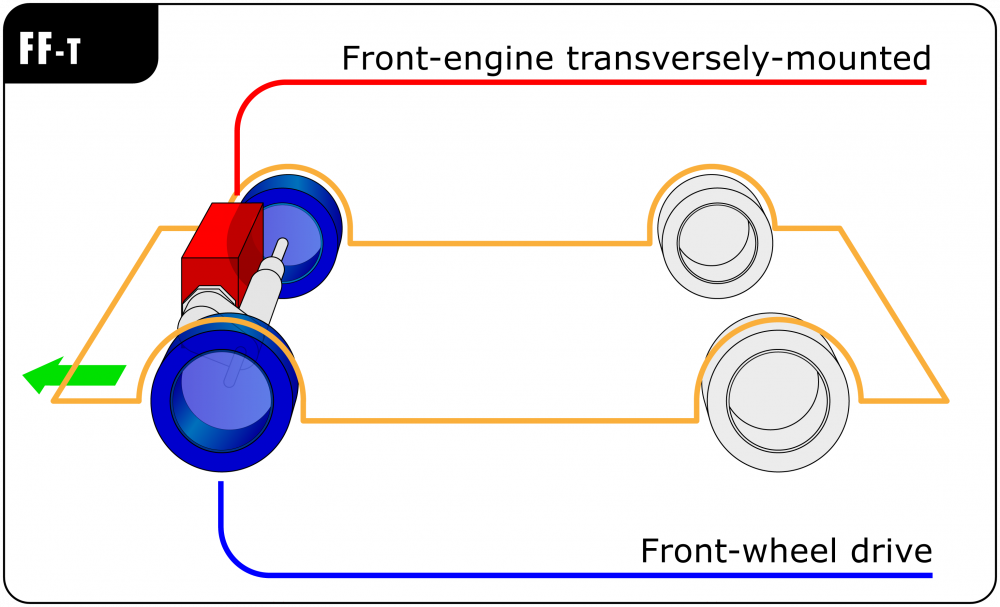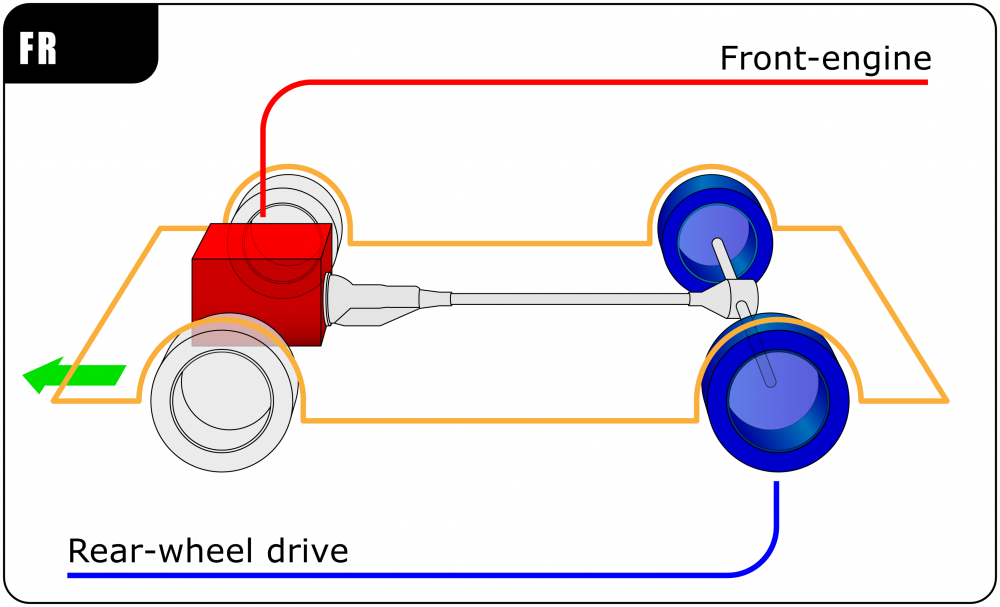Learning to drive a car is pretty easy when you know about your car, technically. One would argue that there is no need to know about the technical details, but trust me, they do help a lot. One such detail is the drivetrain options in the car. There are 3 types of drivetrains namely 2WD, 4WD and AWD. You can read about the different drivetrains in detail here. Today, we are going to take a look at the two types of 2 Wheel Drivetrains available in the market, namely Front Wheel Drive (FWD) and Rear Wheel Drive (RWD). And we’ll also answer the question, why are most of the Indian cars Front Wheel Drive?
But first, let’s take a look at the two drivetrains briefly.
Front-Wheel Drive (FWD)

As the name suggests, cars with FWD have their front wheels powered by the engine. The engine can be mounted transversally or longitudinally. The engine delivers the power to the front axle while the rear axle is a dead one. Let’s take a look at the pros and cons of this type of drivetrain.
Pros:
- Reduced number of parts, no need of the transmission of power to the rear wheels as the engine is directly mounted over the front wheels.
- This results in FWD being less expensive and low maintenance drivetrain.
- All the equipment is in front, which allows more space inside the cabin and better legroom in the rear part.
- The FWD provides better traction while climbing and driving on slippery roads.
- FWD cars are more fuel-efficient, again due to the reduced weight of less number of components required.
Cons:
- One of the major drawbacks is the understeer. As the major part of the weight of the vehicle lies in the front part, it results in understeer.
- The FWD reduces the towing capacity of the vehicle. It cannot be used in the vehicles that are used for towing.
- You can experience ‘Torque Steer’ in the event of sudden acceleration. This means that the car tends to steer to the right or left. This can cause a loss of handling.
Now let’s take a brief look at the RWD.
Rear Wheel Drive (RWD)

The engine is mounted on the front while the power is sent to the rear wheels via a transmission (driveshaft). The number of parts required in this configuration is much more than the FWD. This has got pros and cons too!
Pros:
- Even weight distribution, one of the major advantages of this type of drive.
- The major flaws of FWD such as understeer and torque steer are also removed in this setup.
- For those who love to drift, RWD is the best setup for this. Though drifting is not recommended in normal driving and should only be done in a controlled environment.
Cons:
- The initial cost of this setup is high.
- The fuel efficiency is low. All the added parts such as the drive shaft add to the weight of the vehicle thus resulting in lowered mileage.
- It is hard to control. RWD requires more precision while driving as it pushes the car instead of pulling it. And, as studied in the lower classes, Pushing produces more movement.
So, now the question, why are most of the cars in India Front Wheel Drive?

Its simple, FWD is fuel-efficient, easy to drive and less expensive. Indian buyers prefer fuel efficiency over performance and this is what carmakers have been readily able to adopt. This is the reason that most of the cars in India are FWD. RWD cost more which adds to the overall cost of the vehicle. Some of the well-known cars in India such as Maruti Suzuki Alto, Hyundai Verna, Kia Seltos, Maruti Suzuki Vitara Brezza, Honda City, Tata Altroz, all come with this configuration.
Do you think that carmakers should offer Rear Wheel Drive cars too? Let us know your thoughts in the comments section below.







They must provide RWD cars in low cost. I like RWD cars.
Hi Krishna,
RWD or the Rear Wheel Drive cars require more number of parts which adds to the cost of the vehicle. Keeping it low would result in a compromise with the quality of the material. There are a few RWD cars in India at present such as the Mahindra TUV300. Stay tuned!
What are therthe models available now under 20 lakhs range??
Hi,
Which models are you looking for under 20 Lakhs? Let’s be a bit more precise. 🙂
Is wagon R 2016 model FWD or RWD?
Hi Udit,
A wagon R can do nothing special if it had an RWD drivetrain. Anyhow, Maruti Suzuki Wagon R is FWD.
You missed maruti eeco, its rwd!
The Eeco shouldn’t have been introduced as a private vehicle, sure it’s roomy but the quality does not even conform to the lowest standards. Sure there aren’t cars or vans that are as big and spacious as the Eeco but then as soon as you step in you’re invited by depressing plastic trims and exposed metal. I mean the entire marketing team must have been drunk and high on substance trying to undo losses and then somebody thought the Eeco would be a really good idea. The Eeco’s drivetrain is based on its commercial counterpart, they didn’t bother to make any changes.
I’m not sure if this is the right place for posting this piece and I’m doing it because the subject (AWD/RWD/FWD) is of interest to a lot of us gearheads!
I had posted it (as a thread starter) earlier on one of the forums where I’ve been a member for a while. So if you feel this is not the place please delete it.
This subject has been buzzing around in my head for a while but for one reason or another I have postponed it. I am taking another plunge in the hope that I can start a real debate/discussion on the subject. In informal talks with other buffs I have often found that people do hold views on the subject but have not given much thought to it!
For myself, I will confess that I am firmly in the RWD corner. And the reason is simple – I believe that from an engineer’s point of view, a FWD arrangement is a bean-counter’s solution and not the engineer’s. A FWD set-up is easy to manufacture. The engine, clutch, G/B and undercarriage sub-assembly can be made very compact and the set-up lends itself perfectly for volume production! But – it is not an engineer’s solution. Good engineering practice warrants that the stresses and strains in a mechanical system – a car – should not be concentrated in one region, but distributed as much as possible to keep wear & tear low & prolong life & durability.
In a FWD set-up both steering forces & engine torque forces are concentrated on the front wheels and its attached suspension, steering and drive-line components. And one can imagine the stresses built-up when the car is being driven at full steering lock and at max allowable torque (= throttle) – a situation common enough for me when climbing the steep hairpins of Uttaranchal. It is understood that for wheel articulation (in all 3 axes) universal couplings/CV couplings at both ends of each half-shaft to the front wheels are needed. But the stress concentration (during adverse driving situations as outlined above) due to steering & engine torque remains high in FWD vehicles. And the situation becomes worse as the wheel base keeps increasing. The peak of this engineering joke was reached by the Americans in the 70’s when they decided to follow the European lead in FWD application. GM installed FWD on their full sized goliaths – the Cadillac Eldorado & the Oldsmobile Tornado – both of which were over 18 feet long & had the usual lazy V8s of 7 L displacement! Needless to add that both these died a mercifully quick death due to their impractical lay-out. But the FWD trend continues globally today (Skoda Superb, Nissan Teana, Toyota Camry, Hyundai Sonata and Honda Accord being large WB examples sold in our market). The reason as mentioned earlier is the reduced manufacturing costs & compactness of the package.
But as a concession to this design’s commercial success, it is generally acknowledged that (for a WB < ~2.4 mtrs & overall length < ~3.8 mtrs), the FWD layout, coupled with a monocoque structure, has distinct advantages in handling & agility.
On the other hand, in a RWD set-up, the same situation (stresses due to steering forces & engine torque) is more simply resolved. The steering stresses are all acting on the front wheels and its accompanying suspension & steering components. The engine torque generated stresses are concentrated on the rear wheels and its associated sub-assemblies – the locating arms, the suspension components, & in case of IRS, the half-shafts & their associated bits & pieces. The transmission & drive-line(prop shaft) losses are usually ignored as they are minor in comparison. As one can see, the situation in a RWD set-up is much more in line (in my view! ) with engineering integrity.
And finally, the AWD/4WD set-up, for tackling the difficulties faced in driving over bad terrain – mud, slush, ice & snow and of course off-road "kaccha" surfaces. We have all seen AWD rally cars in WRC events with their stupendous ability to tackle dangerous surfaces. We also know that most of them are equipped with add-ons – limited slip or torque sensing differentials of one kind or another, ESP and other similar software, etc. What fewer people know is that full-time AWD (the Audi Quattro models, eg) requires a central/3rd differential or a viscous coupling (like the AWD version of our home-grown XUV500) to prevent torque wind-up or "chirping" on smooth tarmac with AWD engaged. So, as can be seen, AWD is rather more complex & complicated (=higher maintenance & niggles issues!) than one would like in one's daily commuter. But for the dedicated tourer (who also indulges in occasional & necessary bits of off-roading in his travels!) the investment in AWD may be worth the added expense and – occasional! – maintenance.
I feel the foregoing is an adequate introduction (obviously, the views/opinions expressed are mine only!) and I now hope that our forum members will join in with their own views/opinions/inputs and we can get a lively discussion/debate going!
We live in the country with the highest mountain range and in a terrain like this we need the power of push, but alas we don’t understand performance. We believe in spend less get more. The car companies shouldn’t look at only the sales volumes, they should be mature, less greedy and spoil us for choices, WOE CAPITALISM. They should not give us minimum. Make in India, make rwd!
you have explained FWD & RWD very well and i ma giving your link in my website.
Thanks.
[…] motor is mounted on the front axle hence it’s Front Wheel Drive […]
Very well explained. In simple terms. Excellent write up. Please keep it up.
Thanks for the appreciation!